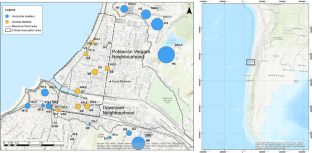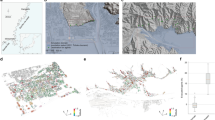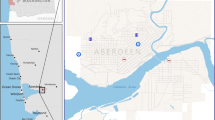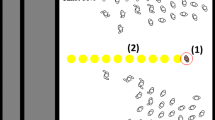Abstract
Tsunami vertical evacuation (TVE) buildings have the potential to save many human lives in countries exposed to near-field tsunamis. Up to now, TVE research has examined three main topics separately: shelter siting, building benchmarks, and decision-making by evacuees. This study aims to integrate these topics to develop more comprehensive TVE planning frameworks. To this, we examined a catastrophic tsunami evacuation scenario in Viña del Mar, Chile. First, we developed an agent-based model to estimate potential human fatalities in the case of a fully horizontal evacuation. Second, we designed an immersive VR experience, which we applied to a sample of 151 people in the city to collect their potential TVE decision-making, which allowed us to identify 11 buildings that could serve as TVE shelters. Lastly, we incorporated this new evacuation system into the former agent-based model to assess the potential impact of vertical evacuation. Our findings showed that while fatalities ranged from 50 to 72% of the population in the fully horizontal scenario, the inclusion of TVE buildings might decrease human losses by 6.5–13.7%. Complementary questionnaires administered to participants highlighted their lack of previous experience in real-world evacuations (only 45.69% had previously experienced a tsunami-related evacuation process), as well as their knowledge about how to proceed in the case of a future emergency (62.91% declared that they knew where to go during an evacuation).





Similar content being viewed by others
References
Aguirre BE, El-Tawil S, Best E et al (2011) Contributions of social science to agent-based models of building evacuation. Contemp Soc Sci 6:415–432. https://doi.org/10.1080/21582041.2011.609380
Álvarez G, Quiroz M, León J, Cienfuegos R (2018) Identification and classification of urban micro-vulnerabilities in tsunami evacuation routes for the city of Iquique, Chile. Nat Hazards Earth Syst Sci. https://doi.org/10.5194/nhess-18-2027-2018
Ashar F, Amaratunga D, Haigh R (2018a) Tsunami evacuation routes using network analysis: a case study in Padang. In: Procedia engineering. Elsevier Ltd, pp 109–116
Ashar F, Amaratunga D, Sridarran P, Haigh R (2018b) Practices of tsunami evacuation planning in Padang, Indonesia. In: Krishnamurthy RR, Jonathan MP, Srinivasalu S, Glaeser B (eds) Coastal management: global challenges and innovations. Elsevier, Amsterdam, pp 399–433
Buchmüller S, Weidmann U (2006) Parameters of pedestrians, pedestrian traffic and walking facilities. Zürich
Cabinet Office Government of Japan (2005) Guideline for tsunami evacuation buildings
Carvajal M, Araya-Cornejo C, Sepulveda I et al (2019) Nearly Instantaneous Tsunamis Following the Mw 7.5 2018 Palu Earthquake. Geophys Res Lett 46:5117–5126. https://doi.org/10.1029/2019GL082578
Carvajal M, Cisternas M, Catalán PA (2017) Source of the 1730 Chilean earthquake from historical records: Implications for the future tsunami hazard on the coast of Metropolitan Chile. J Geophys Res Solid Earth 122:3648–3660. https://doi.org/10.1002/2017JB014063
Dall’Osso F, Dominey-Howes D (2010) Public assessment of the usefulness of “draft” tsunami evacuation maps from Sydney Australia – implications for the establishment of formal evacuation plans. Nat Hazards Earth Syst Sci 10:1739–1750
Dewi RS (2012) A-Gis based approach of an evacuation model for tsunami risk reduction. J Integr Disaster Risk Manag 2:108–139
Ding N, Chen T, Zhu Y, Lu Y (2021) State-of-the-art high-rise building emergency evacuation behavior. Phys A Stat Mech Its Appl 561:125168. https://doi.org/10.1016/J.PHYSA.2020.125168
Engstfeld A, Killebrew K, Scott C, Wiser J (2010) Tsunami safe haven project. Report for Long Beach, WA, Seattle, Washington
Fraser S (2014) Informing the development of tsunami vertical evacuation strategies in New Zealand. Massey University, Wellington
Fraser S, Leonard GS, Matsuo I, Murakami H (2012) Tsunami evacuation: lessons from the Great East Japan earthquake and tsunami of March 11th 2011. GNS Science, Avalon
Goda K, Dasiewicz I, Li S, et al (2013) Tsunami casualty mitigation through vertical evacuation buildings: a case study from the March 11th 2011 Tohoku earthquake. In: Forensic engineering: informing the future with lessons from the past - proceedings of the 5th international conference on forensic engineering. Thomas Telford Services Ltd, pp 137–147
González M (2013) “Evacuación vertical” en Chile: una alternativa posible para evitar víctimas fatales en caso de tsunami. In: 01-07-2013. http://ciperchile.cl/2013/07/01/“evacuacion-vertical”-en-chile-una-alternativa-posible-para-evitar-victimas-fatales-en-caso-de-tsunami/. Accessed 12 Mar 2018
Goto Y, Affan M, Agussabti, et al (2012) Tsunami evacuation simulation for disaster education and city planning. J Disaster Res 7:92–101
Haiqal M, Sari LH, Evalina Z, Hasibuan P (2019) A review of vertical evacuation on tsunami mitigation case. IOP Conf Ser Mater Sci Eng 523:1–8. https://doi.org/10.1088/1757-899X/523/1/012061
Hall S, Pettersson J, Meservy W et al (2017) Awareness of tsunami natural warning signs and intended evacuation behaviors in Java, Indonesia. Nat Hazards 89:473–496. https://doi.org/10.1007/S11069-017-2975-3/TABLES/1
Hassan W, Kakoty P, Ortega M, Simbson B (2018) Efficiency assessment of tsunami evacuation routes in Viña del mar, Chile. In: Eleventh U.S. national conference on earthquake engineering. Los Angeles, CA
Heintz JA, Rojahn C, Coulbourne WL, et al (2019) Guidelines for Design of Structures for Vertical Evacuation from Tsunamis (Third edition). FEMA P-646. Redwood City, California
INE (2018) Censo 2017
Izquierdo T, Fritis E, Abad M (2018) Analysis and validation of the PTVA tsunami building vulnerability model using the 2015 Chile post-tsunami damage data in Coquimbo and la Serena cities. Nat Hazards Earth Syst Sci 18:1703–1716. https://doi.org/10.5194/NHESS-18-1703-2018
Kim K, Kaviari F, Pant P, Yamashita E (2022) An agent-based model of short-notice tsunami evacuation in Waikiki. Hawaii Transp Res Part D Transp Environ 105:103239. https://doi.org/10.1016/J.TRD.2022.103239
Kubisch S, Guth J, Keller S et al (2020) The contribution of tsunami evacuation analysis to evacuation planning in Chile: applying a multi-perspective research design. Int J Disaster Risk Reduct 45:101462. https://doi.org/10.1016/j.ijdrr.2019.101462
León J, Castro S, Mokrani C, Gubler A (2020) Tsunami evacuation analysis in the urban built environment: a multi-scale perspective through two modeling approaches in Viña del Mar, Chile. Coast Eng J. https://doi.org/10.1080/21664250.2020.1738073
León J, Catalán PA, Gubler A (2021) Assessment of top-down design of tsunami evacuation strategies based on drill and modelled data. Front Earth Sci 9:1. https://doi.org/10.3389/FEART.2021.744193
León J, Mokrani C, Catalán P et al (2019a) The role of built environment’s physical urban form in supporting rapid tsunami evacuations: using computer-based models and real-world data as examination tools. Front Built Environ. https://doi.org/10.3389/fbuil.2018.00089
León J, Vicuña M, Gubler A (2019b) Increasing tsunami risk through intensive urban densification in metropolitan areas: a longitudinal analysis in Viña del Mar. Chile Int J Disaster Risk Reduct. https://doi.org/10.1016/j.ijdrr.2019.101312
León J, Zamora N, Castro S et al (2019c) Evacuación vertical como medida de mitigación del riesgo de tsunamis en Chile
Lindell MK, Prater CS, Gregg CE et al (2015) Households’ immediate responses to the 2009 American Samoa earthquake and tsunami. Int J Disaster Risk Reduct 12:328–340. https://doi.org/10.1016/J.IJDRR.2015.03.003
Mas E, Adriano B, Koshimura S (2013) An Integrated simulation of tsunami hazard and human evacuation in La Punta, Peru. J Disaster Res 8:285–295
McCaughey JW, Mundir I, Daly P et al (2017) Trust and distrust of tsunami vertical evacuation buildings: Extending protection motivation theory to examine choices under social influence. Int J Disaster Risk Reduct 24:462–473
MINVU (2013) Diseño estructural para edificaciones en áreas de riesgo de inundación por tsunami o seiche - NTM 007. Santiago
Mostafizi A, Wang H, Cox D et al (2017) Agent-based tsunami evacuation modeling of unplanned network disruptions for evidence-driven resource allocation and retrofitting strategies. Nat Hazards 88:1347–1372. https://doi.org/10.1007/s11069-017-2927-y
Mostafizi A, Wang H, Cox D, Dong S (2019) An agent-based vertical evacuation model for a near-field tsunami: Choice behavior, logical shelter locations, and life safety. Int J Disaster Risk Reduct 34:467–479
Mück M (2008) Tsunami Evacuation Modelling. Development and application of a spatial information system supporting tsunami evacuation planning in South-West Bali. Universität Regensburg
Obando J, Ugalde D, López-García D (2015) HOUSING – Illapel Earthquake. Oakland, CA
ONEMI (2014) Recomendaciones para la preparación y respuesta ante tsunamis. ONEMI, Santiago, Chile
Padilla Almeida O, Matheus A, Cruz M et al (2016) Enhanced vertical evacuation application with geomatic tools for tsunamis in Salinas. Ecuador J Tsunami Soc Int 35:106
Park S, van de Lindt JW, Gupta R, Cox D (2012) Method to determine the locations of tsunami vertical evacuation shelters. Nat Hazards 63:891–908. https://doi.org/10.1007/s11069-012-0196-3
Poulos A, Tocornal F, de la Llera JC, Mitrani-Reiser J (2018) Validation of an agent-based building evacuation model with a school drill. Transp Res Part C Emerg Technol 97:82–95. https://doi.org/10.1016/j.trc.2018.10.010
Raskin J, Wang Y (2017) Fifty-year resilience strategies for coastal communities at risk for tsunamis. Nat Hazards Rev 18:B4016003. https://doi.org/10.1061/(ASCE)NH.1527-6996.0000220
Raskin J, Wang Y, Boyer M et al (2011) An evacuation building project for Cascadia earthquakes and tsunamis. Obras y Proy 9:11–22
SECTRA (2016) Encuesta de Origen-Destino de Viajes Gran Valparaíso. Ministerio de Obras Públicas, Transportes y Telecomunicaciones, Santiago, Chile
Shibayama T, Esteban M, Nistor I et al (2013) Classification of tsunami and evacuation areas. Nat Hazards 67:365–386. https://doi.org/10.1007/s11069-013-0567-4
SHOA (2012) Proyecto CITSU. http://www.shoa.cl/index.htm
Shuto N (2005) Tsunamis: their coastal effects and defense works. In: Tingsanchali T (ed) Scientific forum on the tsunami, its impact and recovery. Asian Institute of Technology, Bangkok, Thailand, pp 1–12
Sugimoto T, Murakami H, Kozuki Y, Nishikawa K (2003) A human damage prediction method for tsunami disasters incorporating evacuation activities. Nat Hazards 585–600
Sun Y, Sun J (2019) Perception, preparedness, and response to tsunami risks in an aging society: Evidence from Japan. Saf Sci 118:466–474. https://doi.org/10.1016/j.ssci.2019.05.060
Suppasri A, Shuto N, Imamura F et al (2012) Lessons learned from the 2011 Great East Japan tsunami: performance of tsunami countermeasures, coastal buildings, and tsunami evacuation in Japan. Pure Appl Geophys 170:993–1018
Suppasri A, Shuto N, Imamura F et al (2013) Lessons learned from the 2011 Great East Japan Tsunami: performance of tsunami countermeasures, coastal buildings, and tsunami evacuation in Japan. Pure Appl Geophys 170:993–1018. https://doi.org/10.1007/s00024-012-0511-7
Velotti L, Trainor JE, Engel K et al (2013) Beyond vertical evacuation: research considerations for a comprehensive “vertical protection strategy.” Int J Mass Emerg Disasters 31:60–77
Voulgaris G, Aleksejeva J (2017) Spatiotemporal identification of potential tsunami vertical evacuation sites: a case study of Shizuoka City. Japan Plos Curr. https://doi.org/10.1371/currents.dis.e66442ce2b19de55532457d967d9645d
Wang H, Mostafizi A, Cramer LA et al (2016) An agent-based model of a multimodal near-field tsunami evacuation: Decision-making and life safety. Transp Res Part C Emerg Technol 64:86–100. https://doi.org/10.1016/J.TRC.2015.11.010
Wang Z, Jia G (2020) A novel agent-based model for tsunami evacuation simulation and risk assessment. Nat Hazards 105:2045–2071. https://doi.org/10.1007/S11069-020-04389-8
Wang Z, Jia G (2021) A novel agent-based model for tsunami evacuation simulation and risk assessment. Nat Hazards 105:2045–2071. https://doi.org/10.1007/S11069-020-04389-8/FIGURES/1
Wood N, Jones J, Schelling J, Schmidtlein M (2014) Tsunami vertical-evacuation planning in the US Pacific Northwest as a geospatial, multi-criteria decision problem. Int J Disaster Risk Reduct 9:68–83
Yagi S, Hasemi Y (2010) Requirements and verification methodology for the design performance of Tsunami-Hinan buildings (temporary tsunami refuge building). J Disaster Res 5:591–600
Yeh HH, Robertson I, Preuss J (2005) Development of design guidelines for structures that serve as tsunami vertical evacuation sites. Washington State Department of Natural Resources, Division of Geology and Earth Resources
Yuzal H, Kim K, Pant P, Yamashita E (2017) Tsunami evacuation buildings and evacuation planning in Banda Aceh, Indonesia. J Emerg Manag 15:49–61. https://doi.org/10.5055/jem.2017.0312
Zamora N, Catalán PA, Gubler A, Carvajal M (2021) Microzoning tsunami hazard by combining flow depths and arrival times. Front Earth Sci 8:747. https://doi.org/10.3389/feart.2020.591514
Acknowledgements
Powered@NLHPC: This research was partially supported by the supercomputing infrastructure of the NLHPC (ECM-02). We also would like to thank Matías Carvajal for providing the fault model of the 1730 earthquake.
Funding
JL, PC, and AG were funded by the Research Center for Integrated Disaster Risk Management (CIGIDEN), ANID/ FONDAP/15110017. JL was also funded by the research Grant ANID/FONDECYT/1210184. PC and AG were also funded by ANID, Chile, through its grant FONDEF ID19I10048. PC was also funded by the Centro Científico Tecnológico de Valparaíso, ANID PIA/APOYO AFB180002.
Author information
Authors and Affiliations
Contributions
This study was conceived and developed by JL and PC. AO carried out the agent-based model and the statistical analysis of its results. AG worked out the tsunami flood model. MC and GB prepared and applied the VR immersive experience, with the help of JC. JL prepared the first version of the manuscript with reviews by PC.
Corresponding author
Ethics declarations
Conflict of interest
The authors have no relevant financial or non-financial interests to disclose.
Additional information
Publisher's Note
Springer Nature remains neutral with regard to jurisdictional claims in published maps and institutional affiliations.
Rights and permissions
Springer Nature or its licensor (e.g. a society or other partner) holds exclusive rights to this article under a publishing agreement with the author(s) or other rightsholder(s); author self-archiving of the accepted manuscript version of this article is solely governed by the terms of such publishing agreement and applicable law.
About this article
Cite this article
León, J., Ogueda, A., Gubler, A. et al. Increasing resilience to catastrophic near-field tsunamis: systems for capturing, modelling, and assessing vertical evacuation practices. Nat Hazards (2023). https://doi.org/10.1007/s11069-022-05732-x
Received:
Accepted:
Published:
DOI: https://doi.org/10.1007/s11069-022-05732-x




